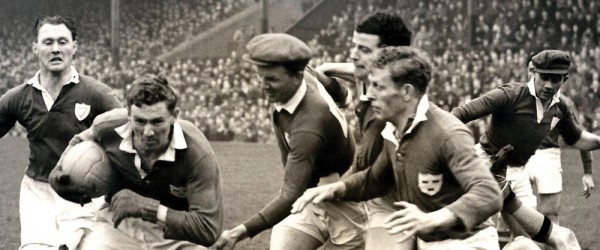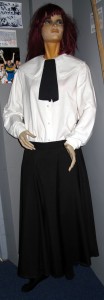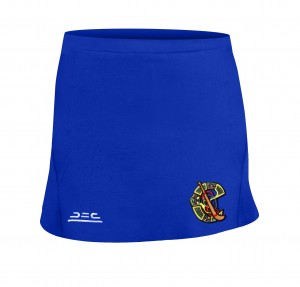5. Camogie Players’ Dress Code
When the Keatings Branch of the Gaelic League extended its activities to camogie in 1904, it had to contend with the fact that the public participation of women in team sports was unheard of until the late 1880s, and was considered ‘socially undesirable’.
The group that drew up the early camogie rules were courageous and enterprising but were also conscious that Victorian dress reflected the place of women in society, which was at home, and that their fashion wasn’t intended to be utilitarian.
The early dress code for camogie players was anything but utilitarian, reflecting how women dressed in public. The rule stated: ‘Skirts to be worn not less than 6 inches from ground.’ The top was a blouse.
In the first camogie match, between Keatings and Cuchulainns, the former wore the skirt according to rule, with light blue blouses and yellow ties, and the latter blue blouses and red sashes over their regulation skirts.
One of the curious things was another of the rules which stated: ‘Intentionally stopping the ball with the skirt was a foul.’ Anybody looking at the skirt worn by the early players in Lár na Páirce museum would be inclined to ask, how was it possible not to stop the ball while wearing such a long skirt!
Mary Moran, who has written extensively on the game of camogie, has this to say about the early dress code: ‘The style of dress of those early players did not lend itself to athletic activity. Long hobble skirts frequently tripped up the wearers.’ She also describes the difficulties with the rest of the outfit: ‘Footwear was also restrictive. Laced or buttoned boots, which often came well up the leg, tended to hamper movement, whereas the alternative consisted of canvas shoes that held no grip on a wet pitch.’
Opposition
The modesty of the attire didn’t find favour everywhere. Some clergy opposed camogie per se, believing the game harmed ‘the morality and purity of women’. The P.P. of Abbeyleix had the local camogie club disbanded in 1911 ‘at his express wish’! As late as February 1934, John Charles McQuaid, then President of Blackrock College, wrote a letter to the Irish Times expressing his strong reservations towards women’s participation in sport.
The only change in the dress code during the early decades came in the 1913 camogie convention when the length of players’ skirts was raised to 8 inches above the ground!
It appears that the dress code began to change towards the end of the 1920s. In Mary Moran’s history of camogie there is a camogie action picture from the 1924 Tailteann Games in which the players are wearing gym frocks and blouses. This outfit may have been decided on especially for these games and may have been gradually adopted by camogie players. There is a photo of a Dublin club team from 1930 wearing the new outfit.
Mary Moran has this to say about the new outfit: ‘By the thirties, the full-length skirt and long-sleeved blouse had been replaced by the gym frock and a less-decorative blouse. Many players were soon to adopt a shirt, which lent itself to activity rather than the more tight-fitting blouse. Canvas boots, with rubber studs, became the fashionable footwear.’
The gym frock and blouse were to remain the standard outfit for camogie players until 1972. It had its critic as early as 1936. The quote is from Mary Moran: ‘Writing under the name ‘Perplexed’, a spectator at the All-Ireland final wrote to the newspaper expressing his/her amazement at finding ‘ the players attired in skirts. One would have thought that this form of ‘athletic’ costume would have been long since relegated to the limbo of forgotten things, where it belongs.’
Transition
There was a transition from the gym frock before 1972. Already, by 1960 approximately, in a girls’ secondary school in Cork, the management of camogie teams began to convert the lower half of the gym frock into a culottes.
The gym frock had one big disadvantage. In the days before tights, there was always a gap between the top of the long stockings worn by the players, which were held in place by suspenders, and the legs of the knickers. One camogie player from the period told me that when she played at university level and when the spectators included a few of the male sex, the latter got a great kick out of shouting ‘Suspender!’, when a player got a tumble!
There is no evidence that this practice of gym frock culottes spread to other teams during the sixties and the gym frock was eventually replaced at the 1972 Camogie Congress.
End of Gym Frocks
The gym frock and black stockings were replaced by divided skirts, sports shirts and bobby socks. The new clothing allowed players more freedom and looked smarter. While the great majority of players welcomed the change, some members were loath to discard the gym frock, and some clubs, and a few counties, continued to dress in the old style for several years. The new outfit got a good launch in the 1973 senior All-Ireland final between Antrim and Cork.
However, the new development led to further problems. In time the divided skirt gave way to an ordinary skirt with shorts underneath. This led to the practice of wearing colourful shorts and a lack of uniformity in the dress code of teams.
The Skort
The solution was found in the skort, a combination of skirt and shorts, which was devised about ten years ago. The two form one unit and more importantly, the same colour uniformity. It has become the common dress for camogie players today and it allows the kind of athletic freedom that ‘Perplexed’ was looking for in 1936. It is also a far cry from the restrictive dress worn by the early camogie players.
But, and there is always a but in an imperfect world! For many camogie players, the skort is still restrictive and a great number of them use ordinary togs when training. Apart from the greater freedom of movement they allow, there is a second very important consideration: price! The togs can be purchased for €10-€15 while the skort costs over twice that amount.
drishane-camogie-team-1959-1960







